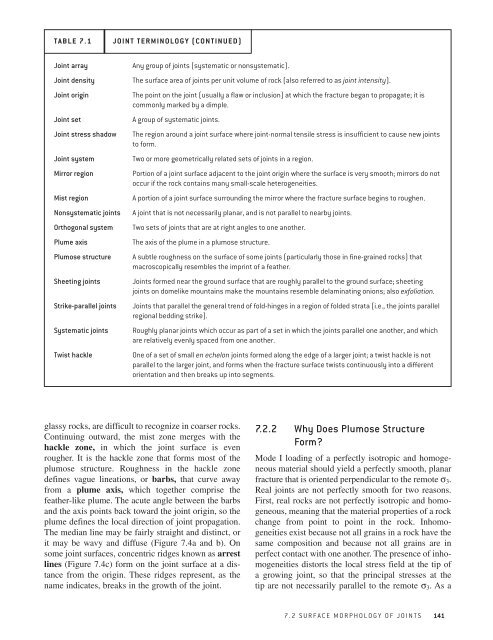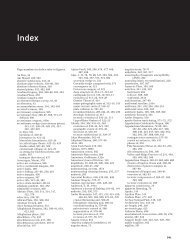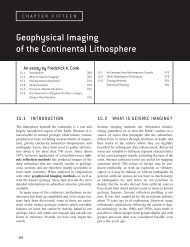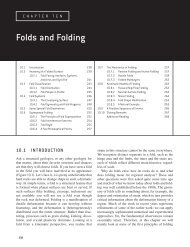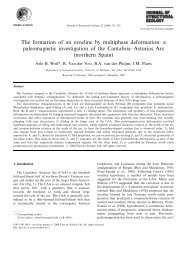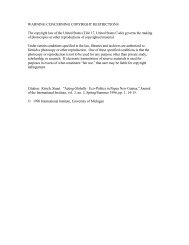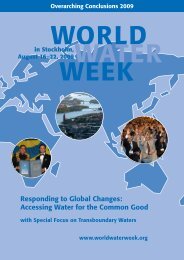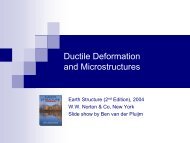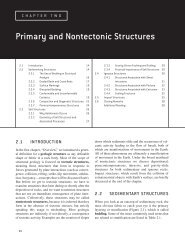Joints and Veins - Global Change
Joints and Veins - Global Change
Joints and Veins - Global Change
- No tags were found...
You also want an ePaper? Increase the reach of your titles
YUMPU automatically turns print PDFs into web optimized ePapers that Google loves.
2917-CH07.pdf 11/20/03 5:10 PM Page 141TABLE 7.1JOINT TERMINOLOGY (CONTINUED)Joint arrayJoint densityJoint originJoint setJoint stress shadowJoint systemMirror regionMist regionNonsystematic jointsOrthogonal systemPlume axisPlumose structureSheeting jointsStrike-parallel jointsSystematic jointsTwist hackleAny group of joints (systematic or nonsystematic).The surface area of joints per unit volume of rock (also referred to as joint intensity).The point on the joint (usually a flaw or inclusion) at which the fracture began to propagate; it iscommonly marked by a dimple.A group of systematic joints.The region around a joint surface where joint-normal tensile stress is insufficient to cause new jointsto form.Two or more geometrically related sets of joints in a region.Portion of a joint surface adjacent to the joint origin where the surface is very smooth; mirrors do notoccur if the rock contains many small-scale heterogeneities.A portion of a joint surface surrounding the mirror where the fracture surface begins to roughen.A joint that is not necessarily planar, <strong>and</strong> is not parallel to nearby joints.Two sets of joints that are at right angles to one another.The axis of the plume in a plumose structure.A subtle roughness on the surface of some joints (particularly those in fine-grained rocks) thatmacroscopically resembles the imprint of a feather.<strong>Joints</strong> formed near the ground surface that are roughly parallel to the ground surface; sheetingjoints on domelike mountains make the mountains resemble delaminating onions; also exfoliation.<strong>Joints</strong> that parallel the general trend of fold-hinges in a region of folded strata (i.e., the joints parallelregional bedding strike).Roughly planar joints which occur as part of a set in which the joints parallel one another, <strong>and</strong> whichare relatively evenly spaced from one another.One of a set of small en echelon joints formed along the edge of a larger joint; a twist hackle is notparallel to the larger joint, <strong>and</strong> forms when the fracture surface twists continuously into a differentorientation <strong>and</strong> then breaks up into segments.glassy rocks, are difficult to recognize in coarser rocks.Continuing outward, the mist zone merges with thehackle zone, in which the joint surface is evenrougher. It is the hackle zone that forms most of theplumose structure. Roughness in the hackle zonedefines vague lineations, or barbs, that curve awayfrom a plume axis, which together comprise thefeather-like plume. The acute angle between the barbs<strong>and</strong> the axis points back toward the joint origin, so theplume defines the local direction of joint propagation.The median line may be fairly straight <strong>and</strong> distinct, orit may be wavy <strong>and</strong> diffuse (Figure 7.4a <strong>and</strong> b). Onsome joint surfaces, concentric ridges known as arrestlines (Figure 7.4c) form on the joint surface at a distancefrom the origin. These ridges represent, as thename indicates, breaks in the growth of the joint.7.2.2 Why Does Plumose StructureForm?Mode I loading of a perfectly isotropic <strong>and</strong> homogeneousmaterial should yield a perfectly smooth, planarfracture that is oriented perpendicular to the remote σ 3 .Real joints are not perfectly smooth for two reasons.First, real rocks are not perfectly isotropic <strong>and</strong> homogeneous,meaning that the material properties of a rockchange from point to point in the rock. Inhomogeneitiesexist because not all grains in a rock have thesame composition <strong>and</strong> because not all grains are inperfect contact with one another. The presence of inhomogeneitiesdistorts the local stress field at the tip ofa growing joint, so that the principal stresses at thetip are not necessarily parallel to the remote σ 3 . As a7.2 SURFACE MORPHOLOGY OF JOINTS141


